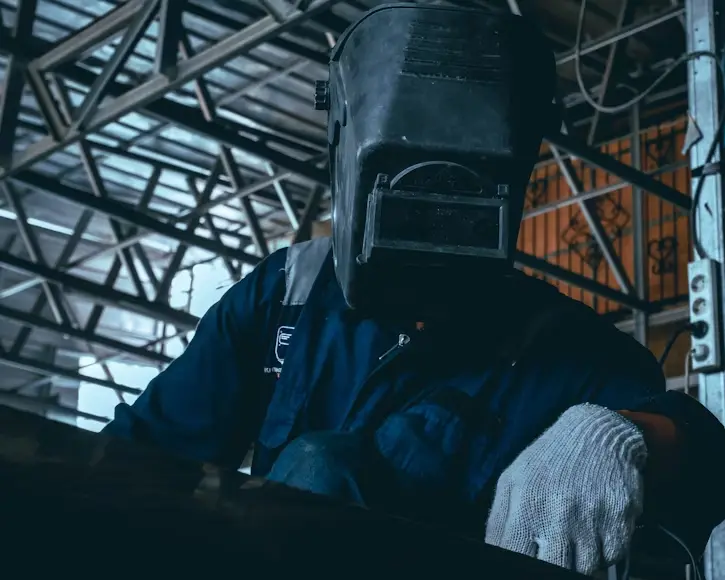Curious why safety standards are important in custom steel fabrication?
Every year thousands of metal fabrication workers are seriously injured or killed on the job. Machine accidents, burns, falls, cuts and lacerations, chemical exposure, and toxic fume inhalation are all real and present dangers for your team.
The good news?
Safety standards and best practices are proven to reduce accidents and prevent injuries in metal fabrication. When you implement a custom steel fabrication safety program your team and your business are protected.
Here’s what we’ll cover:
- Why Safety Standards Are Critical
- The Current State of Steel Fabrication Safety
- Essential Safety Equipment Every Shop Needs
- OSHA Compliance For Custom Steel Fabrication
Why Safety Standards Are Critical
Safety standards in custom steel fabrication aren’t a checkbox you can tick.
They’re a commitment to keeping your team safe when they work with potentially dangerous heavy machinery, high heat, and hazardous materials and chemicals. When your team knows that their health and safety matters, you build a culture of trust and commitment.
Here’s the thing:
Custom steel fabrication services have some hazards other industries don’t. Custom steel fabrication involves cutting, welding, grinding, and forming operations which create a host of safety concerns all at once.
Quality custom steel fabrication services understand that safety standards and protocols are essential at every stage of fabrication. From cutting and shearing to grinding and finishing to heat treatment and protective coating and powder coating in Benton, Wisconsin, every step of the process is different. Each needs its own safety equipment and training to keep workers safe.
And when safety standards are overlooked?
The results can be tragic and ruinous, not just for injured workers but for your business.
The Current State of Steel Fabrication Safety
Show me a successful company and I’ll show you one that takes safety seriously.
Check this out…
Recent industry data shows the global steel industry reported 67 deaths across the industry in 2024. 67 families. 67 lives.
But here’s some better news:
The lost time injury frequency rate for the steel industry fell to 0.70 in 2024. This is the lowest ever recorded. It shows that when companies implement robust safety programs they make a difference.
U.S. OSHA data for 2024 shows a total of 527,116 injury and illness cases reported by employers. Roughly 90% of these are injuries and 10% are illnesses. The highest citation percentages for both of these categories were machine guarding violations, respiratory protection hazards, and fall protection failures. This tells us that while safety is getting better, companies can’t afford to be complacent about safety.
Essential Safety Equipment Every Shop Needs
Let’s be honest here.
If you want to run a safe and successful steel fabrication shop you need the proper equipment. You need gear that actually does its job and protects your workers from the hazards they face every day.
Personal Protective Equipment (PPE)
This is an obvious one, but I want to make sure we cover the bases. Every person in your shop must have access to quality personal protective equipment (PPE) that keeps them safe:
- Safety glasses with side shields to protect eyes and face
- Welding helmets with proper shade numbers for all welding operations
- Heat resistant gloves for various tasks
- Steel-toed boots
- Hearing protection for noisy areas
- Respiratory protection for welding fumes
But here’s what most people don’t realize…
It’s not enough to have the equipment. Your team must know how to use it correctly and do it every single time without fail.
Machine Guarding
Machine guarding is one of the top 10 areas that OSHA cites companies on. Moving machine parts can cause crushed fingers and hands, amputations, burns, blindness, and death. These are the hazards you’re guarding against.
Your fabrication machines and equipment need proper guards in place on:
- Press brakes
- Shears
- Grinders
- Punch presses
- Rolling machines
Any machine part that can pinch, cut, crush, or otherwise injure a person must have some type of guarding. Full stop.
Ventilation Systems
Welding stainless steel and other custom steel fabrication projects release fumes and particulates into the air that can harm your team. Welding fumes can cause:
- Nose and throat irritation
- Dizziness
- Nervous system damage
- Even lung cancer
That’s why proper ventilation systems are key. Local exhaust ventilation should capture fumes right at the source before anyone can breathe them in.
OSHA Compliance For Custom Steel Fabrication
If you want to avoid expensive OSHA fines and keep your workers safe then you need to know the agency’s rules for metal fabrication.
Hazard Communication Standard
OSHA has a Hazard Communication Standard (HCS) that makes it clear that every employee has the right to know what hazards they may encounter on the job. This includes:
- Maintaining Safety Data Sheets (SDS) for all hazardous chemicals used in your shop
- Proper labeling of all containers
- Training workers on chemical hazards
- Use of pictograms and hazard warning labels
This is not an area where you can cut corners. Welding fumes containing hexavalent chromium are especially dangerous and require additional safety measures to keep workers safe.
Respiratory Protection Program
Companies where workers are exposed to harmful airborne contaminants must have a written respiratory protection program that includes:
- Medical evaluations for workers who must wear respirators
- Fit testing for tight-fitting respirators
- Training on proper use and maintenance
- Regular inspection of equipment
The latest data shows that 89% of companies are now using proactive safety metrics, like safety audits and risk assessments to improve their safety performance. Companies with safety-centric programs have 17% higher productivity than those without.
Emergency Action Plans
Every steel fabrication shop must have an Emergency Action Plan (EAP) in place that covers:
- Fires
- Chemical spills
- Medical emergencies
- Evacuation procedures
- Emergency contact numbers
Your team must know this plan inside and out. Practice regular fire and emergency evacuation drills so everyone knows what to do when time is of the essence.
Record Keeping Requirements
OSHA requires companies with more than 10 employees to keep records of serious workplace injuries and illnesses. This means keeping:
- Form 300 (Log of Work-Related Injuries and Illnesses)
- Form 301 (Injury and Illness Incident Report)
- Form 300A (Annual Summary)
Employers must keep these records for at least 5 years.
Building A Safety Culture
Let me tell you something important…
Safety standards are useless if you and your team aren’t all in on following them 100% of the time. You must build a company culture where safety is first priority and is never compromised.
That means:
- Regular safety training
- Open communication about hazards
- Empowering workers to stop unsafe work
- Recognizing and rewarding safe behavior
- Learning from near misses
The top fabrication shops in the country don’t just meet safety standards. They exceed them. Process safety management is also gaining more traction as an essential element in the industry. This approach to preventing catastrophic accidents relies on operational, engineering, and management skills to effectively reduce the potential for accidents and injuries.
Key Takeaways
Custom steel fabrication services require comprehensive and effective safety programs to protect workers and ensure compliance.
The facts are clear: companies that prioritize safety have lower injury rates, reduced costs, and increased productivity. Machine guarding, respiratory protection, and proper PPE are non-negotiable.
Remember these key points:
- Stay up-to-date on OSHA requirements for metal fabrication companies
- Invest in quality safety equipment
- Train your team regularly
- Keep records of all incidents and training
- Build a safety culture where every team member has safety top of mind
Don’t let an accident be what motivates you to take action on safety. Invest in your team’s health and well-being today. You and your workers will thank you for years to come.
Workers should expect to go home healthy and safe at the end of every shift. With proper safety standards in place, that’s a goal that is well within reach.
The steel fabrication industry is making great strides. Lost time injury rates are the lowest they’ve ever been. But there’s always more work to do. Every fabrication shop has a responsibility to do everything in their power to protect workers and uphold the highest safety standards.
Start today. Review your safety protocols. Train your team. Identify gaps. Fix them. Because in safety, good enough is never good enough.
Also Read-The Evolution of Online Gaming Rewards: From Free Spins to No Deposit Bonuses



